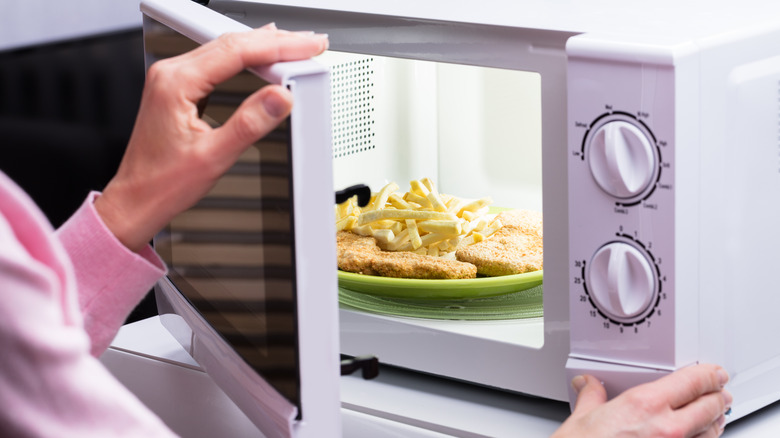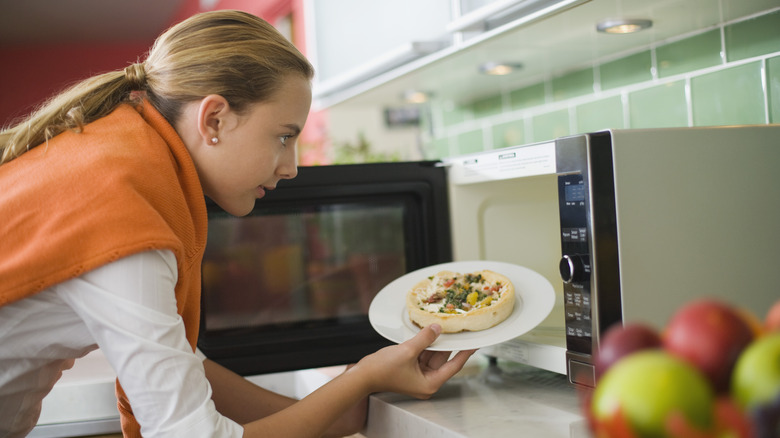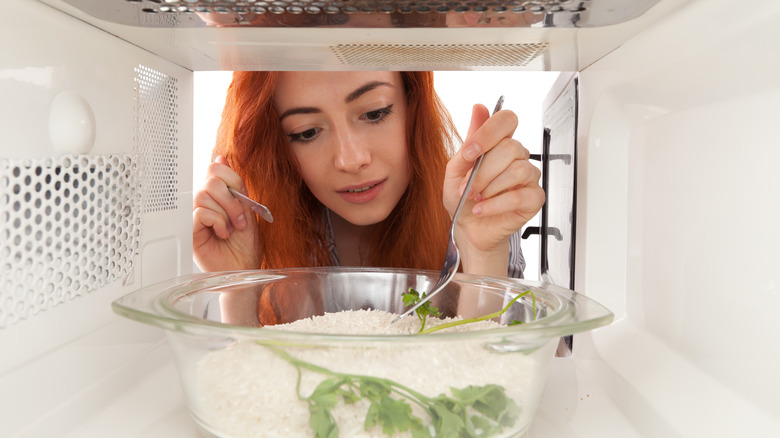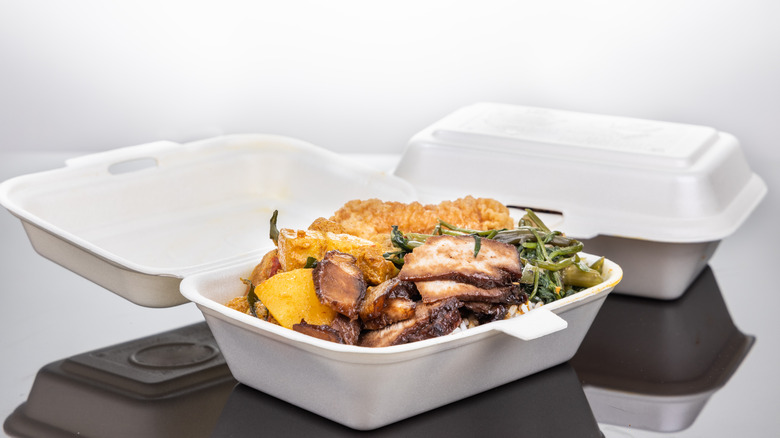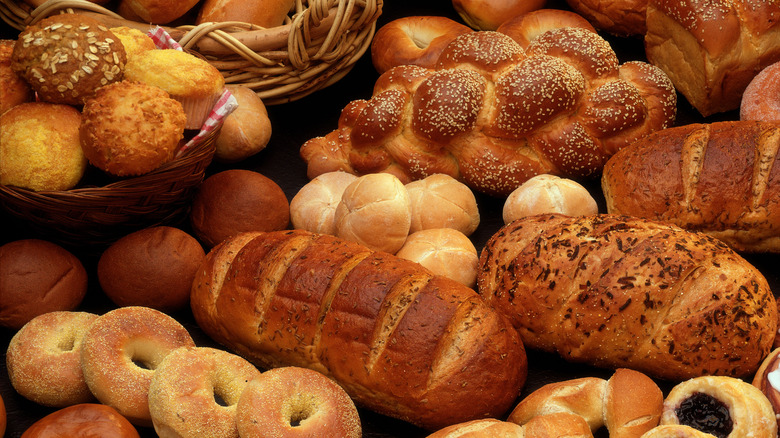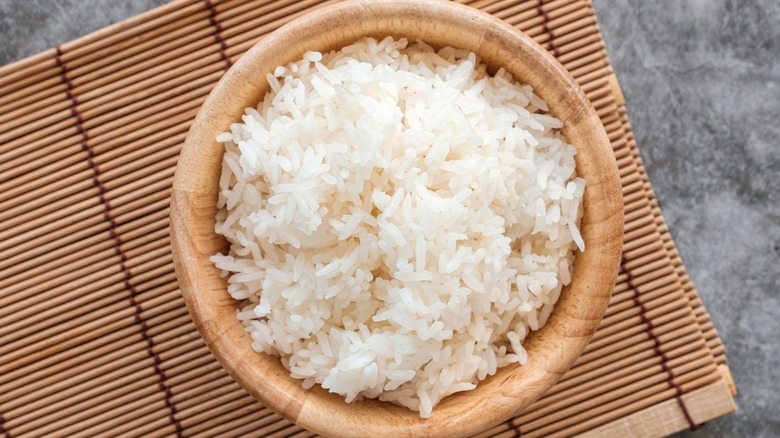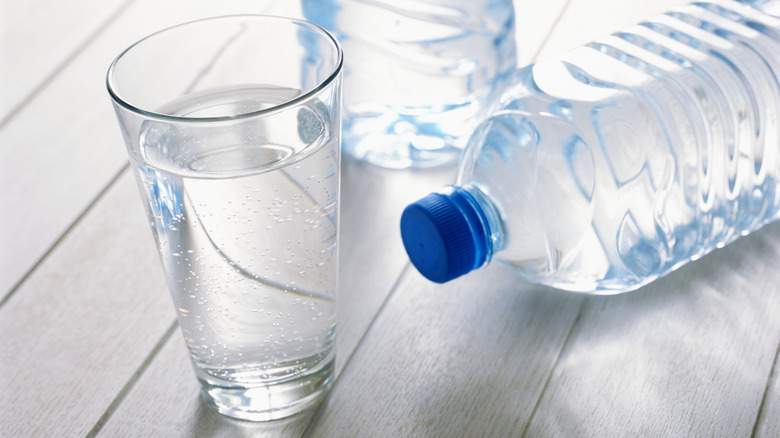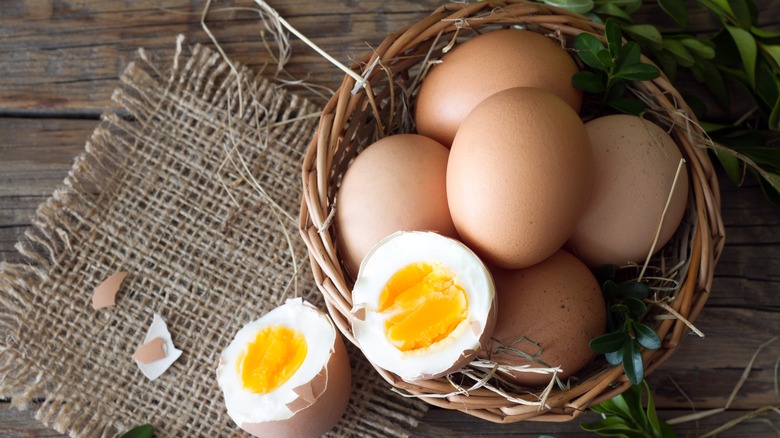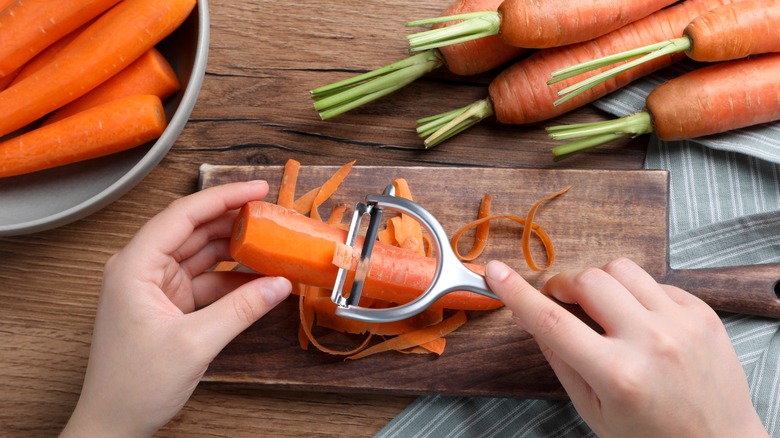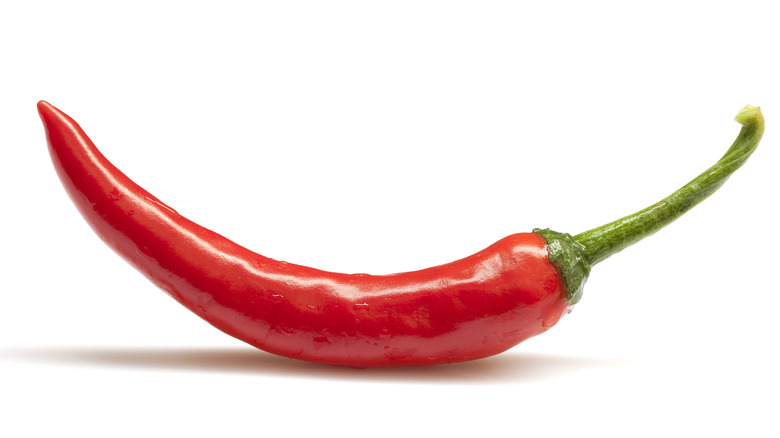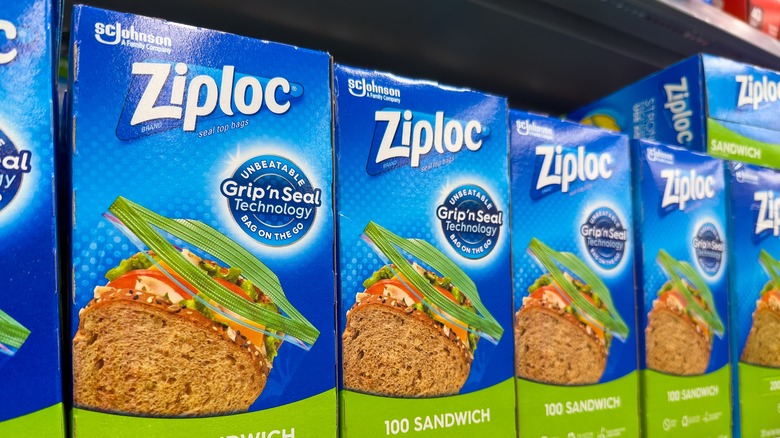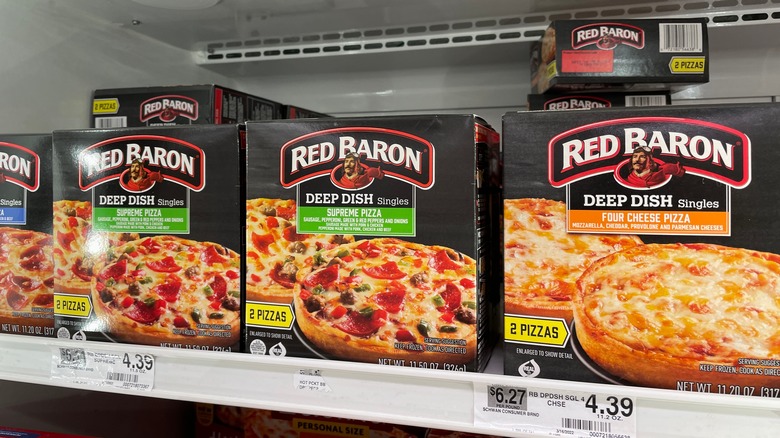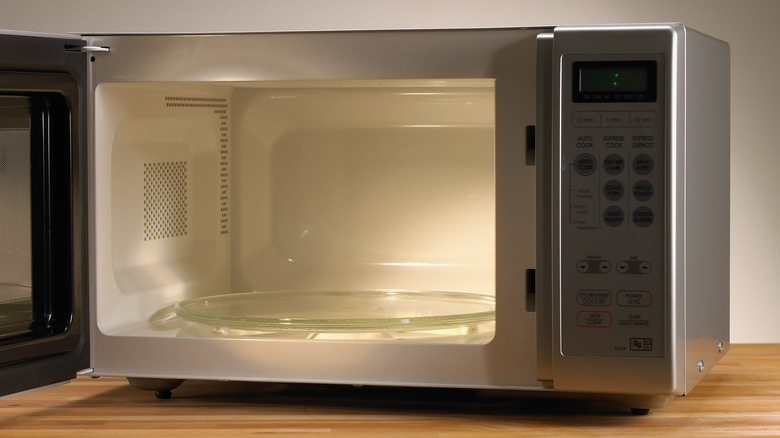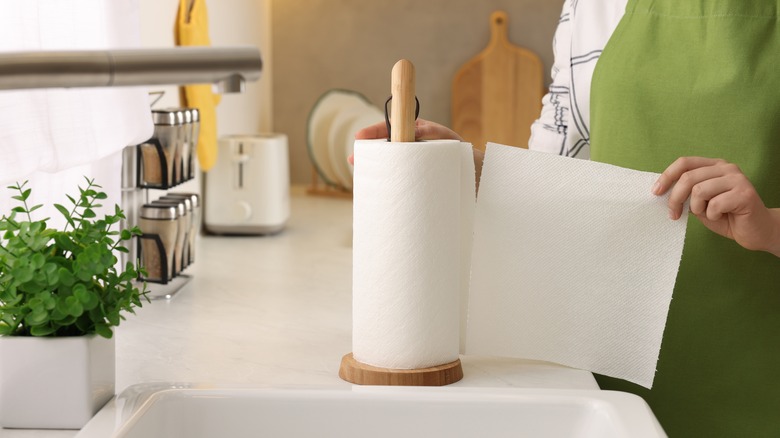Think Twice Before Putting These Common Things In The Microwave
We may receive a commission on purchases made from links.
In 1945, one Percy Spencer, a brilliant self-taught engineer, received a patent for a groundbreaking invention of his: the microwave oven. Cooking hasn't been the same since this uber-convenient appliance hit the market. Yet despite its popularity and presence in the homes of millions, not everyone has the record straight about what should and shouldn't go in the microwave. You might know the most obvious no-nos, including the errant fork or crumpled tin foil, but some other hazards might shock you (literally).
Even after 80 years of technological advancements, manufacturers haven't figured out how to make some innocuous-looking things microwave-safe. In this list, you'll learn about the top 13 items you should keep away from the interior of your microwave oven. Some of them are head-scratchers, others are obvious upon a second thought, but all have the capacity to damage you, your microwave, or your whole home. Take heed in order to keep sparks, smoke, and even flames out of your kitchen.
Food without a lid
In the presence of intense heat, any kind of dish with a liquid component — from soups to curries to lasagna — can easily bubble over. This is all the more true in the microwave, which offers an enclosed environment that both amps up the heat and traps in messes. If your food overflows or (forbid it!) explodes, you'll have a disaster all over the inside of the oven.
Putting a lid on your dishes is one way to make sure that the bubbling-over action stays inside the proverbial kettle, so to speak. In other words, don't put an uncovered bowl or plate in the microwave. A cover prevents any splattering action from decorating the inside of your microwave with pizza sauce, meat juices, hot water, and other liquid-y stuff that makes a yucky mess if allowed to run amok. A cover can even help your food cook a bit faster by trapping in heat.
That said, if you're using a plastic container, you'll want to leave the lid slightly ajar to allow steam to vent. Tightly-sealed plastic vessels don't offer a place for heat to escape, which can also lead to explosions.
Any metal items
If you were allowed to microwave your own food as a kid, you probably got a stern warning from the adults in your life: Metal utensils never belong in there. But did you know that metal can sneak in through less obvious ways? Think about the thin wire handle on a Chinese takeout box, a mug or thermos with a steel coating, and even dishes with metallic paint or decorations. You absolutely need to search your items for metal before nuking them, or you might have a fire on your hands.
The radioactive waves that give the microwave its name heat your food as they bounce around inside the appliance. These microwaves have electrons in them which interact with the water molecules in your food. When steam is released from your meal, these electrons are also discharged. However, when metal is introduced to the mix (especially bent or crinkled metal like tin foil), electrons can go haywire.
Unlike water, which releases the bouncing electrons via steam, metal doesn't have that quality. The electrons start to cluster in one spot, then violently release their energy via fire and mini-electrical storms. The bottom line: Don't microwave anything that might contain even a little bit of metal.
Styrofoam containers
The last thing you want when you order takeout is tacos or french fries with a side of Styrofoam chemicals. You don't have to worry about that just because your meal is delivered in a Styrofoam box, but if you microwave your takeout in that same container, some contamination is inevitable. This is because the heat from the microwave melts Styrofoam boxes and brings out chemicals from the polystyrene foam.
Styrene is a compound that has been linked to nervous system afflictions and even cancer. While studies on this subject are related to working with plastics like styrene, rather than ingesting tiny amounts, you probably want to stop microwaving Styrofoam anyhow. Avoiding it is easy and prevents chemicals from leaching into your food, turning it into a yucky-tasting result that's potentially hazardous to your health.
Unless your Styrofoam container carries a label indicating that it's microwave-safe, it's best to take your leftovers out of the container they came in. The microwave-safe label looks like a series of water waves, with either a graphic of a bowl or a microwave on it. If you don't see this symbol, heat up your leftovers in a microwave-safe container, like a glass bowl with a lid.
Bread, rolls, and muffins
Anyone who's ever tried to reheat bread in the microwave knows that it winds up less soft and warm and more like a rubbery blob or leaden brick. This transformation from a crusty, delicious slice to a hockey puck happens because the heat from the microwave changes the bread's sugar molecules. Once the sugar molecules in bread heat up to 212 F or higher, they melt, turning them from soft and well-integrated into a crystallized mess.
These sugar crystals will then harden, which is why your bread feels very chewy and almost rubbery when it comes out of the microwave before turning rock hard in a matter of minutes. The same thing happens to muffins, donuts, and other bread-adjacent items. The best way to reheat a loaf of bread or other baked treat is to bypass the microwave and pop it into the oven instead. Just wrap it in a blanket of foil and warm it in a pre-heated oven.
If you don't want to try the oven, you can opt for a skillet; just be sure to flip bread slices frequently, and know that heating up muffins or other goods will trickier. And of course, a toaster is best if you want to breathe new life into just one or two slices of bread.
Rice
Loves of Asian food probably look forward to leftover plain or fried rice, but from a food safety perspective, microwaving this starchy staple can be risky. Rice leftovers sometimes contain a bacteria called Bacillus cereus, a bug that can earn you a lot of time bent over the porcelain throne, if you catch our drift. And even reheating doesn't kill off these dangerous germs, which is why many sources caution against microwaving old rice. That being said, there are some steps you can take to sidestep this risk.
First, always cook and store rice at a high or low-enough temperature to keep bacteria at bay. Temps between 40 to 140 F are the "danger zone," according to the United States Department of Agriculture. This range greatly encourages bacterial growth, so whether you steam rice on the stove or use a rice cooker, cook it piping hot, then store leftovers in a cold fridge ASAP. Cooked rice should only be left out of the fridge for an hour or less. After that, you open up the possibility of bacterial development.
Once rice is in the fridge, don't allow it to linger for more than a day. If you can't eat it the next day, throw it out. And when microwaving rice, you'll want to heat it for longer than you think — at least 3 or 4 minutes, or until steaming hot throughout (no cooler spots anywhere!).
Single-use plastic
You wouldn't slice up a plastic container and eat it with a knife and fork, would you? Yet when you heat up certain plastics in the microwave, you'll basically be eating them once you consume the food or drink they're touching. Some plastics constantly release microscopic particles into materials they're in contact with, and heating them up in the microwave speeds up this release process.
This isn't to say you can never microwave plastic — doing it cautiously starts with identifying microwave-safe containers. One-time use plastic containers, like water bottles, takeout trays, or margarine tubs, are among the most volatile plastics that tend to release micro-particles into your food. Instead, only heat up microwave-safe plastic containers. You can examine the container itself to find a symbol or instruction that says if you can microwave it or not. When in doubt, just don't do it.
Ideally, you would heat your food in glass containers instead. However, not all glass is microwave-safe, either, and the wrong kind can easily shatter. To prevent this, look for the microwave-safe label on your glass bowls, too. Usually, manufacturers place this symbol on the bottom of a bowl or glass.
Hard-boiled eggs
If you've ever seen a scary video of a poorly-ventilated pressure cooker blowing up, you have some idea of what happens inside an unpeeled, hard-boiled egg when it's heated in the microwave. The outer layer of the egg functions a bit like the self-contained exterior of a pressure cooker. When the contents get too hot and there's no way to relieve the build-up, what's inside gets pushed up and has to go somewhere, resulting in leaking or the whole thing busting wide open.
The moisture inside a hard-boiled egg gets heated up by microwaves to a boiling point, and since the shell doesn't have a pressure valve, the steam inside the egg makes it explode. You may have heard of a lot of useful hard-boiled egg hacks, but reheating them in the microwave — no matter how quick and easy it seems — is not one of them. Instead, immerse your eggs in a pot of hot water and allow them to sit for 10 minutes or so. Put a lid on the bowl or pan to keep the heat inside. Your eggs will heat up evenly without exploding all over the kitchen.
Hot dogs, carrots, and sliced grapes
Who'da thunk that few carrot sticks could turn into Fourth of July sparklers in the microwave? If you try nuking this veggie, you might see an alarming series of flashes inside the oven. This is because carrots contain metallic minerals, such as magnesium, iron, copper, and selenium. Kale, sliced grapes, bell peppers, spinach, and even hot dogs count among the foods that can light up your microwave like an Independence Day fireworks show. In the case of hot dogs, salts and additives in the meat might be spark-inducing.
This strange phenomenon is called arcing, and it doesn't always happen. You might microwave some mixed veggies and have it turn out fine, only for the next time to result in a fire or the electricity in your kitchen flickering on and off. Factors like watery (i.e. flame-retardant) ingredients on top of your food and the environment in the microwave can discourage arcing, so if you nuke a creamy carrot casserole instead of plain carrots, it'll probably be okay. But you'd probably prefer to avoid sparks, fires, and power outages altogether. If you do decide to risk it and heat these veggies in the microwave, watch for sparks and stop the oven immediately if you notice any.
Hot peppers
Bell peppers are another veggie that can spark in the microwave, and so can chile peppers, their hot-headed cousins — but that ain't the only reason why it's a bad idea to toss a few hot ones in the microwave. Given enough nuke time, chile peppers essentially become pepper spray without the can.
Chile peppers are filled from end to end with capsaicin, a hot oil that not only makes food taste spicy, but is a major ingredient in pepper and bear spray. A microwave agitates and releases this compound, which then hits you in the face the minute you open the door. And yes, your body will respond in the same way as if you'd gotten pepper-sprayed. Your eyes, nose, and lungs will burn like crazy, a painful result that could last at least half an hour. The severity of the symptoms may vary, depending on how many peppers you microwaved and for how long, but who wants to argue details when your eyes and nostrils are burning?
In case you wind up in this very unfortunate situation, moving to an environment with fresh air, splashing clean water on your face, and getting out of any clothing that got sprayed are a few steps to take right away. The better move, of course, is to never microwave your chiles — and don't forget to keep capsaicin-covered fingers off your face.
Zip-top plastic bags
If you like to stash your leftovers in a resealable plastic baggie, you've probably at least contemplated reheating them in the same bag to save time and dirty dishes. While some zip-top bags are labeled as safe for the microwave, this can vary from brand to brand, and even product to product. It's the same deal as single-use plastics and Styrofoam: Potentially harmful substances can leach into your food as the bag heats up. Always check your box or package of plastic bags to see if you can microwave them, and even if the manufacturer says it's safe to do so, you need to take several precautions.
First, place the bag on a microwave-safe dish or plate. Then, create a steam vent in the bag by opening the top by about one inch. Finally, as you microwave it, watch the bag for signs of melting. Although the plastic in microwave-safe bags shouldn't leach chemicals, it will still melt if the food inside it gets too hot. Even if no melting occurs, you could get burned if you touch the hot bag, so open the microwave and let it rest until it's cool enough to grab. Honestly, it might be easier to just dump your leftovers out of the bag and heat them in a dish, instead.
Cardboard boxes
With the advent of microwavable meals sold in cardboard boxes, you might be tempted to heat the food right in its package – but just because you can, doesn't mean you should. Cardboard boxes need glue and other chemicals to remain intact. When microwaved, these substances heat up and ooze out of the box, and potentially into your food. For frozen meals that are meant to be microwaved, the food is usually wrapped in protective plastic or another barrier to the cardboard shell, making the microwave a safer option. If your takeout leftovers are in a cardboard box, though, glue and other foreign substances can seep right in.
Adding to this, cardboard can light up like a Christmas tree if it gets hot enough; 400 F, to be exact. You can't set the temperature of your microwave like you can with an oven, so microwaving a cardboard sleeve or box for more than a few minutes can get dangerous. Even when you're heating up microwave-safe cardboard, it's a good idea to check its progress every 30 seconds or so and to cook it on the lowest setting possible, to avoid starting a countertop bonfire.
Nothing
To keep your microwave from wearing out too soon, or even catching fire, you should only run it when food or liquid is inside. Leftover mac and cheese or a cup of slightly tepid coffee can soak up the large number of microwaves that bounce around the oven's interior. In contrast, when these microwaves have nowhere to go, they essentially start cooking the inside of the appliance instead.
If you heat up an empty microwave, your unit may stop working — or it may start blazing. If you've accidentally run the microwave with nothing in it for more than a scant few seconds, you need to test the unit to make sure it's still safe to use. Microwave something simple like a mug of water. If the oven runs fine, with no erratic behavior or sparks, it should be okay to use. If it doesn't operate or works improperly, you may have damaged it.
You can likely get your microwave repaired and continue to use it, but it's best not to have to explore that possibility. Always keep food or liquid in the microwave while it's running, whether you're reheating tea or using lemon water to clean the inside.
Paper towels
Who hasn't grabbed a paper towel and placed it on top of a dish before popping it into the microwave? It's a quick and easy win-win — or is it? Many lazy cooks can tell horror stories about paper towels catching on fire in the microwave, making them risky as last-minute lids. Some towels are mostly safe to use in the microwave, but others may contain trace amounts of metal picked up from manufacturing equipment — and as we already know, that leads to sparking or even flames after a long stint in the microwave.
Something to keep in mind when using a paper towel in the microwave is to check the label to see if your product is microwave-friendly. Also important is the cooking time, so check your paper towel-topped food at two-minute intervals to prevent overheating. And it's worth mentioning that even if your paper towels don't catch fire, the liquid from your food may bubble over, wetting the towel and causing it to sink into the dish. This creates a mess at best and a burn hazard at worst, so it's probably better to reach for a bowl or dish with its own lid.
